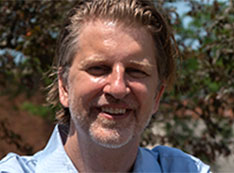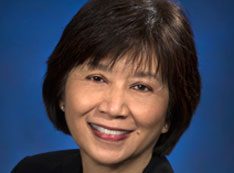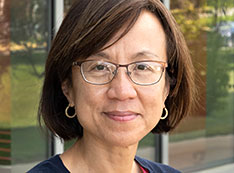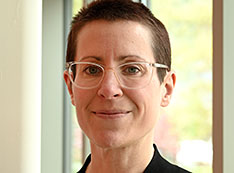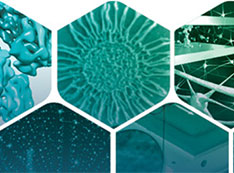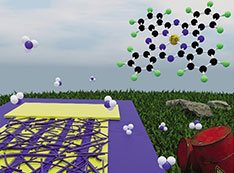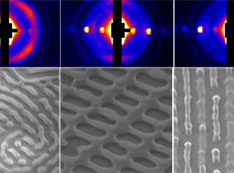Reaching for New Horizons at the 2023 NSLS-II, CFN & LBMS Users' Meeting
This year's Users' Meeting invited scientists, collaborators, and leaders from three of Brookhaven Lab's user facilities to share their research
May 17, 2023
By Cara Laasch and Laura Mgrdichian-West
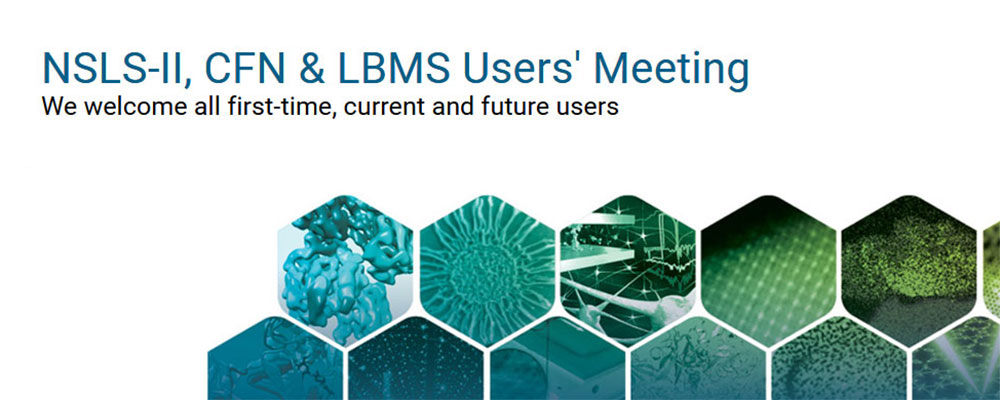
UPTON, NY—This year, the Users’ Executive Committees (UECs) of the Center for Functional Nanomaterials (CFN) and the National Synchrotron Light Source II (NSLS-II)—two U.S. Department of Energy (DOE) Office of Science User Facilities at DOE’s Brookhaven National Laboratory—were delighted to welcome a third facility at Brookhaven Lab, the Laboratory for BioMolecular Structure (LBMS), to the meeting. LBMS is a state-of-the-art center for life sciences imaging that offers access to advanced cryo-electron microscopes for studies of the building blocks of all living organisms and their behavior.
As a result of the broadened scope, the meeting attracted more than 750 registered attendees from nearly 300 different institutions to join the scientific discourse. The meeting was held virtually from April 24 to 28, and featured a plenary session, an awards session, 16 workshops, a virtual and physical vendor exhibition, and a virtual poster session.
Science, facilities, and more
Diana Monteiro, NSLS-II UEC vice-chair, and Andreas Liapis, CFN UEC chair, welcomed attendees to the meeting during the Plenary Session on Tuesday. They conveyed their excitement about this year’s meeting as they presented the program of the day, ranging from poster award presentations to a keynote address from Linda Horton, associate director for science for Basic Energy Sciences (BES) in the DOE Office of Science. The first speaker was Interim Brookhaven Lab Director Jack Anderson. In his welcoming words, Anderson spoke about the exciting projects in Brookhaven’s future, such as the Electron-Ion Collider and the new beamlines at NSLS-II, as well as the arrival of JoAnne Hewett —the new lab director—this summer. He highlighted the essential role that users’ meetings play as forums for communication and exchange between the user communities and the facilities.
Following Anderson was this year’s keynote speaker, DOE’s Linda Horton, who said she was delighted to return to the Users’ Meeting. Horton began her presentation by highlighting how DOE BES fulfills its mission of “supporting basic research to discover new materials and design chemical processes that underpin a broad range of energy technologies, by expanding research in underrepresented communities, by operating world-class scientific user facilities in x-ray, neutron, and electron beam scattering as well as in nanoscale research, and by managing construction and upgrade projects to maintain world-leading scientific user facilities.”
Next, she spoke about the new leadership that has joined BES—the program managers for x-ray and neutron scattering facilities—and how these new leaders will help guide the ongoing and upcoming upgrade, construction, and extension projects at all user facilities.
She said she was happy to announce the successful launch of the BES User Facility Science Webinar Series to celebrate and communicate user facility impact. The kickoff event took place January 27, 2023, with four speakers from across the nation.
Horton explained that the goal of this webinar series is “to enhance communication on BES User Facility science, highlighting contributions to the national scientific priorities of Clean Energy, Microelectronics, Advanced Manufacturing, and Biopreparedness.”
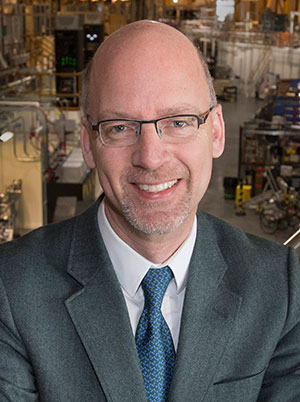
John Hill, NSLS-II Director
Aside from discussing the outreach activities and the impactful science from the user facilities, Horton also spoke about the re-baselining of the facilities’ budget that has been requested. She ended her presentation by summarizing future funding opportunities and important initiatives, such as the Energy Earthshots and the Microelectronics Science Research Centers, to showcase how BES will continue to support science in the coming years.
The next speaker was NSLS-II Director John Hill, who said, “I am delighted to see that our user program continues to thrive and recover from the COVID dip. This year we’ve already had 1247 unique users, which is well above the pace of last year. And I expect us to return to or even exceed the pre-COVID numbers this year.”
The breakdown shows that 80 percent of NSLS-II users come on site at least once a year for their beam time and that 35 percent of all users are first-time users, which is roughly the same percentage as for the first NSLS. Hill then presented three examples of impactful science results from research at NSLS-II. He spoke about how NSLS-II beamlines helped link lung disease in soldiers to toxic metal that they inhaled from burn pits, how NSLS-II staff members and users developed a new technique to study elusive magnetic domain wall movement, and how staff and partners work on using AI to drive autonomous experiments at two beamlines simultaneously.
The next part of Hill’s talk was directed towards the future. Hill highlighted the commissioning effort at the High Energy Engineering X-ray Scattering (HEX) beamline, the ongoing construction of three new beamlines, and the planned development of a new infrared beamline. In addition to these efforts, the facility has also received the green light to start developing eight to 12 new beamlines over the next 10 years. For this project, called NEXT-III, two to three beamlines will be selected at a time, based on proposals from staff and users. The first set will be selected in summer 2023.
“Our vision is to be an extraordinary hub for the users of synchrotron light to solve the world’s most challenging scientific problems that will improve our lives for decades to come,” explained Hill. “And I am proud to say that we are having an impact. With almost 50 percent of our publications being published in journals with an impact factor higher than seven, we are producing impressive science. Our high-end instruments help, of course, but what really matters are the interactions between us and you, our users. This is where the science happens and it is wonderful that we are having such impact together.”
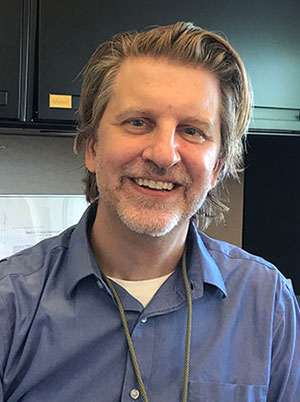
Chuck Black, CFN Director
Following Hill, CFN Director Chuck Black spoke about the importance of in-person interactions in scientific research, noting that while the CFN supported a record number of users in 2022 and that users reported a high satisfaction rate, “2022 maybe didn’t feel like a good year, did it?” He compared the high numbers of users to what we all experienced in the CFN hallways, labs, and interaction spaces, which felt too quiet and empty this year. Black encouraged the audience to check out the work of Dr. Robert Waldinger, MD, the director of the Harvard Study of Adult Development, which has shown that the strength of people’s relationships are the strongest indicator of their leading happy, healthy, fulfilling, and meaningful lives.
“We had a good year in 2022, but I think we can be even better. In 2023, let’s work to rediscover the most powerful CFN resource: our culture of working together.”
Black introduced two new CFN group leaders—Sara Mason and Judy Yang—and other new staff members. He reminded the audience of CFN capabilities for remotely engaging with users in their research. Finally, Black highlighted the new CFN capabilities available, including sample holder-based cryo-electron microscopy that complements the new LBMS facility, enhanced in situ/operando surface science techniques for measuring materials in their working environments, and the Quantum Material Press (QPress), which helps users build quantum materials by robotically stacking atomically thin 2D materials.
“There’s only one QPress in the world, and it’s here in the CFN. It’s an exciting new instrument and already popular with users. And QPress makes Brookhaven a one-stop shop for people interested in 2D materials: you can build the material here, and study it in many ways both in CFN and at NSLS-II,” said Black.
Black finished by returning to the topic of scientific collaboration, pointing out that “doing science” is hard and requires resilience in the face of many difficult setbacks. Community are relationships are the keys to helping us “lose well,” and remain energized to try again.
“I’d like us all to keep in mind that on top of the amazing capabilities, dedicated staff, and talented users present in the user facilities, our most essential resource is our community. Let’s all strive in the next year to make our way back to each other. Bring your best ideas, and let’s work together.”
Once the talks had ended, the audience had the opportunity to ask questions to all speakers, leading to a lively discussion about research opportunities.
Capabilities and excellence as far as the eye can see
The early afternoon of the plenary session was dedicated to a set of flash talks representing the wealth of scientific tools available for researchers. Silvana Westbury, project manager of Lightsources.org, introduced the audience to the network of synchrotron light sources and free electron lasers. Brandon Brough, the Director of the National Nanotechnology Initiative, spoke about the nanocenters across the nation. And to close out the session, Michael Sakalian, a program director at the National Institute of General Medical Sciences at the National Institutes of Health, highlighted the growth and success of cryo-EM centers within the U.S.
Following this rapid introduction to the available capabilities, Tabbetha Dobbins, professor at Rowan University, gave a presentation about inclusion, diversity, and equity in the research world. She based her presentation on her work as a member of the Task Force to Elevate the Representations of African Americans in Undergraduate Physics and Astronomy (TEAM-UP) from 2017 to 2019. This report outlines five factors that are important to increase the number and percentage of African American students obtaining a bachelor’s degree in physics or astronomy. The team was commissioned by the American Institute of Physics. Its five findings were belonging, physics identity, academic support, personal support, and leader and structure, which create a supportive and welcoming environment. She then outlined how these findings can be transferred to user facilities.
The final part of the plenary session was the award ceremony for all the award winners this year. The UEC Community Service for beamline support was awarded to Ira Waluyo, while the Community Service Award for scientific support was awarded to John Trunk and Jimmy Biancarosa. The African-American Advancement Group (AAAG) awarded Ketsia Zinga, University of Texas Austin, with the Gus Prince Award, and the UEC awarded Senay Ustunel, Kent State University, with the Julian Baumert Award. The NSLS-II, CFN & LBMS Users’ Meeting poster prizes went to Alexandra Seletskaya (Shoreham-Wading River High School), Sabrina Cassese (West Islip High School), Angel D’Oliviera (University of Delaware), and Ankita Mohanty (Stony Brook University).
For those who missed the event, the recordings of all presentations can be found on the Users’ Meeting website.
Scientific workshops “all the way down”
The 2023 Users’ Meeting featured 16 scientific workshops covering a wide range of topics. Researchers presented scientific studies and results ranging from protein-protein interaction to computational modeling, showing the true breadth of research done at all three user facilities.
Additional information, including full recordings, can be found for each of the following workshops:
- Workshop #1 -User Facilities 101: Techniques, Applications, and Access
- Workshop #2 - Multiscale TEM/STEM Techniques for Analysis and Characterization on Nanomaterials for Clean Energy
- Workshop #3 - Current and Potential Soft X-ray and Tender Spectroscopy and Scattering Capabilities at NSLS-II
- Workshop #4 - Scientific Python for Data Acquisition, Management, and Analysis
- Workshop #5 - Fluid Transport in Nanomaterials for Sustainable Energy and Water Production
- Workshop #6 - Cryo-EM at LBMS: Protein Structures, Protein-Protein and Protein-Cell Interactions
- Workshop #7 - A New Era in Sample Return Missions: Synchrotron Analysis Opportunities Beyond Earth Materials
- Workshop #8 - SPM User Meetup and Hands-on Open-source SPM Software "Hack a day” with Special Focus on Automatization of SPM
- Workshop #9 - Curation, Data Analysis and Computational Modeling of Xray Absorption Spectroscopy
- Workshop #10 - Multimodal Correlative Studies of Functional Nanomaterials
- Workshop #11 - Structural Analysis of Highly Disordered Materials Using Total Scattering
- Workshop #12 - Multimodal and Multi-scale Bioimaging for Biomedical and Bioenergy Research
- Workshop #13 - Recent Advances in Simultaneous Infrared and Raman Spectromicroscopy
- Workshop #14 - New Science Enabled by Ultra-high Throughput Crystallography
- Workshop #15 - Nanoscale Structure in Quantum Materials Under External Stimuli
- Workshop #16 – Working Toward Wellness, Equity, & Liberation in a Nanoscience Center: Sharing Lessons Learned and Discussing Future Ideas
The workshops were well attended with lively discussions. NSLS-II and CFN look forward to hosting their next joint Users’ Meeting in 2024.
The two UECs would like to thank all sponsors of the 2023 joint User’s Meeting.
Brookhaven National Laboratory is supported by the Office of Science of the U.S. Department of Energy. The Office of Science is the single largest supporter of basic research in the physical sciences in the United States and is working to address some of the most pressing challenges of our time. For more information, visit science.energy.gov.
Follow @BrookhavenLab on Twitter or find us on Facebook.
2023-21267 | INT/EXT | Newsroom




